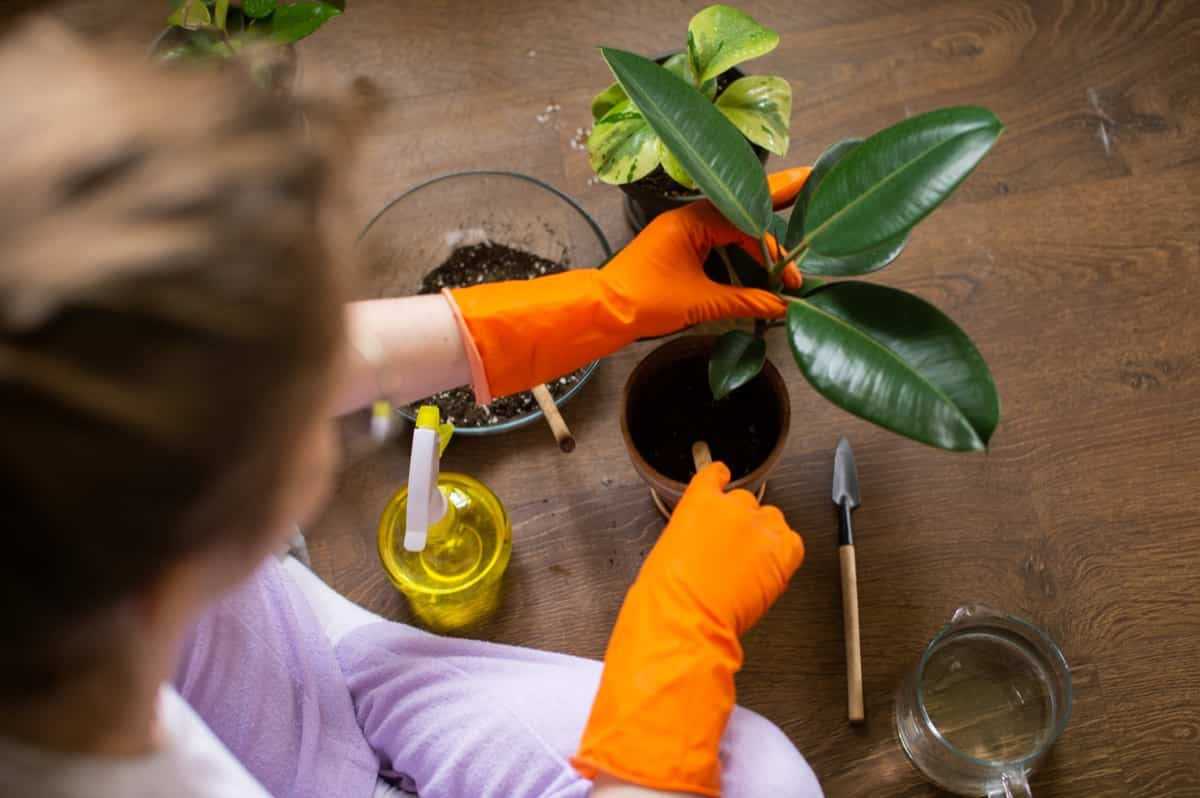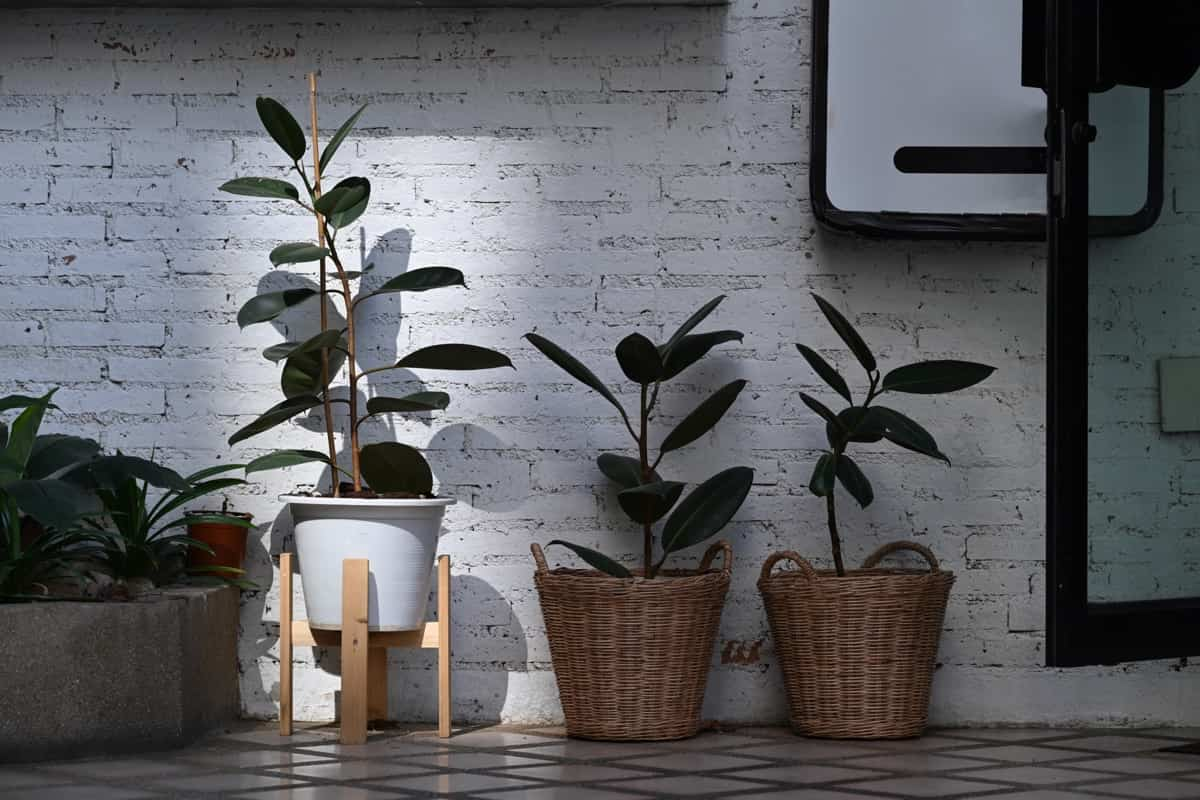The Rubber Plant, scientifically known as Ficus elastica, is a popular indoor plant known for its glossy, dark green leaves. Native to Southeast Asia, it has become a favorite among plant enthusiasts due to its easy care requirements and aesthetic appeal. Rubber Plants can reach a height of 30 meters in their natural habitats and produce natural rubber from their milky saps.

In indoor settings, it typically reaches a height of 2-3 meters. A bright, indirect light environment is best for this plant and well-draining soil. The soil should be watered regularly, allowing it to dry out slightly between waterings. Proper care makes the Rubber Plant a beautiful addition to any home or office space.
Rubber Plant Care
Choosing the Right Location for Your Rubber Plant: Light and Temperature Requirements
When choosing a location for your rubber plant, it is essential to consider its light and temperature requirements. Rubber plants thrive in bright, indirect light, ideal for well-lit rooms or areas with filtered sunlight. Don’t place them in direct sunlight, as it scorches the leaves.
In terms of temperature, rubber plants prefer a warm and humid environment. They are comfortable in temperatures between 15-24°C. They can tolerate slightly cooler temperatures but may suffer in extreme heat or cold. Avoid exposing them to extreme temperature fluctuations or drafts.
The Importance of Proper Watering Techniques for Rubber Plants
To ensure their health and longevity, proper watering techniques are crucial. Overwatering can result in root rotting and other fungal diseases, while underwatering causes the leaves to wilt and drop off. The key is to strike a balance by watering your rubber plant when the top soil is dry.
It is important to use well-draining soil and pots with drainage holes to prevent waterlogging. Additionally, using lukewarm water is recommended, as cold water can shock the plant. Regularly monitoring the moisture levels and adjusting watering accordingly will help ensure rubber plants’ optimal growth and vitality.
- How often do you water rubber plants in summer? In spring and summer, rubber tree plants should be watered every 7 to 10 days.
- How often do you water rubber plants in winter? Rubber tree plants typically need watering every 14 to 21 days in autumn and winter.
In case you missed it: How to Make Rubber Plants Bushy: Best Homemade Fertilizers, Composting, and Pruning Tips

Fertilizing Your Rubber Plant: Tips and Best Practices
The ideal NPK for rubber plants is 24-8-16, which means the fertilizer should contain a higher percentage of nitrogen and potassium compared to phosphorus. Look for a slow-release granular fertilizer that provides a steady supply of nutrients over time. Apply the fertilizer as per the instructions on the package, usually every two to three months during the growing season.
If you prefer organic options, there are several organic fertilizers available that are suitable for rubber plants. Look for organic fertilizers with a balanced NPK ratio, such as compost or well-decomposed manure. Rubber plants are active growers during spring and summer. How often should I fertilize my rubber plant? Fertilize your rubber plant every two weeks during this active growing period to provide the necessary nutrients for healthy growth.
Reduce or stop fertilization in fall and winter when the plant’s growth slows down. Regularly inspect your rubber plant for signs of nutrient deficiencies or excesses. Yellowing leaves, stunted growth, or leaf drop can indicate a nutrient issue. Adjust the fertilizer application accordingly or seek professional advice if needed.
Pruning and Propagating Rubber Plants: How to Maintain Shape and Promote Growth
If your Rubber tree plant is too tall, they don’t get enough light. Prune off the leggy growth to encourage branching. By removing dead or damaged branches, you improve the overall appearance of the rubber plant and encourage new growth. Start by inspecting the plant and identifying any weak or diseased branches. Use clean and sharp pruning scissors to make clean cuts, avoiding tearing or ripping the plant tissue.
Rubber plants should be pruned during the spring or early summer when they are actively growing. When pruning, leave a small stub above the leaf node to prevent rotting. Regular pruning controls the size of the plant and prevents it from becoming leggy. Rubber plants can be propagated through two methods: air layering and stem cuttings.
Air layering involves creating a wound on a healthy branch, applying rooting hormone, and wrapping it with moist sphagnum moss. After roots form, the branch can be cut and potted. Stem cuttings should be taken from the plant’s healthy stems and rooted in a well-draining soil mix. Regular misting and indirect sunlight will aid in the propagation process.
Preventing and Controlling Common Pests and Diseases in Rubber Plants
Several measures can be taken for preventing and treating common pests and diseases in rubber plants to ensure their health and productivity. Firstly, it is important to maintain good hygiene in the growing area. Regularly remove any fallen leaves or debris that may harbor pests or diseases. Additionally, inspect the plants frequently for signs of infestation or infection. Early detection will help to prevent the spread of pests and diseases.
In case you missed it: How to Grow Rubber Plant/Tree from Cuttings: DYI in 10 Simple Steps

To control pests, consider using organic insecticides or biological control methods. These options are less harmful to the environment and can effectively manage pests. When it comes to diseases, ensure proper watering and avoid over-fertilization, as these conditions can promote disease development. If a disease is detected, promptly remove and destroy infected plants to prevent further spread. Regularly monitor the plants and consult with experts to identify and treat any specific pests or diseases.
Creating the Ideal Humidity Levels for Your Rubber Plant
Creating the ideal humidity levels for your rubber plant is vital to its health and growth. Rubber plants thrive in moderate to high humidity environments, ideally between 50% to 60%. To achieve this, you can use a humidifier or place your plant on a water-filled tray with pebbles. Do rubber plants like misting?
Misting the leaves regularly can also help increase humidity. Avoid placing your rubber plant near heating or cooling vents, as they can cause fluctuations in humidity. Remember to monitor the humidity levels regularly using a hygrometer and make adjustments as needed.
Potting and Repotting Your Rubber Plant: Choosing the Right Container and Soil Mix
Potting and repotting your rubber plant requires careful consideration of the container and soil mix. If you decide to purchase a new container, choose one that is slightly larger than the one you are currently using to allow room for growth. Make sure it has drainage holes so that water won’t accumulate.
When choosing a soil mix, choose one that drains well and is nutrient-rich. Mix peat moss with perlite and potting soil evenly as a soil mix for rubber plants. This combination promotes healthy root growth and prevents waterlogging. Remember to repot your rubber plant every 1-2 years or when it outgrows its current container. Following these guidelines will help your rubber plant thrive.
Reasons and Treatment for Rubber Plant Leaves Falling Off
Rubber plant leaves falling off can be attributed to several reasons. One common cause is overwatering, which leads to root rot and, eventually, leaf drop. Inadequate lighting is another factor, as rubber plants require bright, indirect light to thrive. Low humidity levels can also result in leaf loss, so it is important to provide sufficient moisture.
In case you missed it: How to Get Bigger Buds During Flowering: Techniques, Tips, and Ideas

Additionally, pests such as mealybugs and spider mites can cause damage and lead to leaf drop. To treat the issue, adjust watering practices, ensuring the soil is well-drained. Place the plant in a well-lit area but avoid direct sunlight. Increase humidity levels by misting the leaves or using a humidifier. If pests are present, use appropriate insecticides or natural remedies to eliminate them.
Conclusion
By following these tips for Ficus elastica tree care+, you can ensure your rubber plant remains healthy, vibrant, and a beautiful addition to your indoor space. Remember to provide adequate light, water, and humidity, and maintain a regular pruning and fertilization schedule to keep your Ficus elastica thriving.
- Feed Your Flock for Less: Top 10 Tips to Save on Chicken Feed
- Ultimate Guide to Ossabaw Island Hog: Breeding, Raising, Diet, and Care
- Hatching Answers: The Top 10 Reasons Your Chickens Aren’t Laying Eggs
- Eggs and Economics: Breaking Down the Cost of Raising Backyard Chickens
- Defend Your Greens: Proven Methods to Keep Iguanas Out of Your Garden
- Ultimate Guide to Cinnamon Queen Chicken: A Comprehensive Guide for Beginners
- Ultimate Guide to California Tan Chicken: Breeding, Raising, Diet, Egg-Production and Care
- Ultimate Guide to Marsh Daisy Chicken: Breeding, Raising, Diet, and Care
- 10 Types of Chicken Farming Businesses You Can Start for Profits